Abstract
Industry 4.0 (I4.0) grew from and is guided by smart manufacturing. The fourth industrial revolution’s I4.0 would induce radical changes and transformations in the everyday operations of businesses and people’s life. Due to these major changes impacting all sectors and industries worldwide, the sustainability of the new future systems and operations is pertinent. The current research literature points out that the social (human factor) aspect is relatively underrepresented in the I4.0 sustainability-related studies. The few studies related to the social aspect usually investigate the so-called ‘techno-centric’ approach to the subject. This study aimed to investigate the I4.0 construction project management (PM) profession from the socially sustainable ‘worker-centric’ approach. Five key assets of the new I4.0 project managers role, specifically in the construction industry, were explored to achieve this goal. This was conducted through a survey questionnaire aimed at 100 construction project managers based in Gulf Cooperation Council (GCC) region. The overall research results showed that academic and professional qualifications were found to be key factors in the process of adapting to the new I4.0 methodologies.
1. Introduction
1.1. The ‘Techno-Centric’ and the Socially Sustainable ‘Worker-Centric’ Approach in I4.0
Traditionally, the success of a construction project is defined as a construct that included budget, time and quality. Longer-term project success, however, is about sustainability. I4.0 is often viewed as a strategy that Western manufacturing organizations adopt to compete with low-cost producers [1]. This view leads to the ‘techno-centric’ approach, which implies that I4.0 technologies are the key driver to improve organizational performance, and the result of increasing automation is the reduction and loss of jobs, competencies, expertise and know-how. This view implies that machines can replace the human workforce. The majority of research studies adopt this ‘techno-centric’ approach. In contrast, the second socially sustainable perspective is the so-called ‘worker-centric’ factory, where employees play a crucial role in the organization because they cooperate and manage the new I4.0 technologies. Recent research studies argue that social sustainability and employee empowerment are not possible via the ‘techno-centric’ approach, and they recommend a shift towards a ‘worker-centric’ view. [2,3,4].
Project managers have a crucial role in the development of sustainable I4.0. They are the principal agents of this change, and for this, their skills, attitudes and management style should be aligned with the I4.0 trends [5,6]. It is suggested that every employee in I4.0 be required to have specific project management skills [7,8]. Additionally, an I4.0 specific skill set will also be required to traditional project management knowledge [9].
The crucial role of employees and the social dimension for the success of I4.0 developmental priorities has been pointed out by several researchers of the field [7,8,10]. However, the subject area of social dimension is significantly underrepresented in the literature, resulting in an important research and application gap [1,2,4]. Technologies could be bought, but employee engagement is hard to achieve. Unmotivated, uninterested employees or workers who even potentially feel threatened by new technologies may lead to an economic loss, the rejection of the I4.0 adoption and the unsustainability of future progress. As it is still not crystal clear to many what fully realized I4.0 would look similarly to or how it will operate [2,4], it is important to assess not only the deliverable benefits but to consider all the possible concerns as well [11].
The general picture emerging from the relevant I4.0 research literature is that human knowledge (knowledge that is difficult for machines to copy or learn) is key for the socially sustainable ‘worker-centric’ approach. Therefore, it is of great importance to understand those aspects of knowledge, which are essentially human. [4,12,13,14].
The relationship between humans and machine technologies developed gradually along a path paved by industrial revolutions. Industrial revolutions could be described as ‘stepping tones’ driven by technology to spur global progress. It has been suggested that subtle layers of human existence have been increasingly exposed due to industrial revolutions [15] and that soft skills will be the last to be modeled and replaced by technology. Therefore, this is the most valuable asset for I4.0 [6]. In this regard, the concept of ‘bounded rationality,’ introduced by [16] and further developed by research into the role of intuition and emotion in decision-making [5,17], becomes increasingly relevant for understanding the impact of I4.0, exploiting its benefits and avoiding the risks. Wiig proposes that support for employees to work effectively and produce quality results was significantly impacted by intuition-guided decisions rather than logical reasoning [17].
As Su-Yen Wong explained, “we [humans] know they [computers] can out-calculate us, but there are things that make us uniquely human, and that is where future jobs lie.” [13]. It is important to strategically concentrate on these ‘uniquely human’ areas because the rapid development of artificial intelligence (AI) can already potentially disrupt the sustainable social outcomes created by I4.0 technologies with even more jobs moving from workers to machines [4,14]. Even though robots can significantly reduce labor costs and human error, as AI substitutes the human factor even in jobs based on human contact (for example, sales or customer service), there are still jobs that are resistant to automation. These are the ones that codes or algorithms cannot define. They are associated with perception, creativity and the ability to manage complex situations, flexibility, critical thinking, developing theories, literature or composing music. The other area of automation resistant professions are the ones where social intelligence and comprehension is required. These tasks cannot be replaced by machines [13,14].
1.2. Key I4.0 Implications of the Socially Sustainable Approach for Project Management
The first introduction to the concept of ‘Industrial 4.0’ was in 2011 by the German Government in during the Hanover Fair. It was later brought up again in 2013 in the “Recommendations for Implementing the Strategic Initiative I4.0” report. This strategy is now responsible for globally referred to as the Fourth Industrial Revolution (I4.0). I4.0 concept is particularly suitable for the manufacturing and IT industry, but its applicability to other industries remains uncertain.
This new I4.0 age has two consequences from the worker-centric approach: increased knowledge intensity and continuous adaptations of I4.0 technologies [1]. This is echoed by Klaus Schwab, founder of the WEF (Davos Forum), who considers talent and knowledge “talentism” the new “capitalism” [18]. Steven Hankin introduced the ‘War for talent’ expression in 1997. “The reason why knowledge is emerging as the most important strategic aspect in business operations because it is closely associated with gaining a competitive edge” [19]. As the process of digital transformation unfolds, knowledge is now an essential component in the equation for business success [20,21]. Further to the ‘Age of Talent’ phenomena, Harvard University has come up with an ‘Atlas of Economic Complexity’ as metrics to visualize the new age’s economic dynamics and growth opportunities [22], attempting to measure the amount of productive knowledge.
In I4.0, a specific type of knowledge, ‘tacit knowledge,’ could be considered a source of sustainable competitive advantage as it is difficult to imitate, especially for machines [23]. As Polanyi in 1966 [24] phrased it as “we know more than we can tell,” Tacit knowledge can be defined as a certain type of knowledge that is not codified and potentially is not easily expressed. As noted in the past, “professional experiences and expertise are considered to rely on tacit knowledge, the knowledge we use unconsciously and can-not entirely put into words” [25]. In order to achieve this knowledge, both intuition and in-sight seem viable routes. Therefore, by tapping into these skills, the innovative capabilities of work teams might be significantly improved [26].
According to Nonaka (1991), knowledge creation and tacit knowledge dissemination are called socialization [27]. While the explicit knowledge creation and dissemination methods are well understood and researched, the case is not the same with tacit knowledge. Collins (1974) described that generally mentioning that workers in scientific specialties formulate ‘social circles’ [28]. Price (1963) referred to these types of group arrangements as ‘Invisible College’ and the “social location of distinctive sets of technical and cognitive norms” [29]. It is suggested that tacit knowledge transfer is not possible by formal ways, so there should be a study of social networks to track the path of knowledge that the person possessing it is not aware of [30]. Barabasi put forward the ‘Network thinking’ idea proposing that a person does depict not only the value of his/her own knowledge but also the accumulated knowledge available in his/her network [31].
The above description of the key implications of the PM profession’s worker-centric approach is already pointing towards a certain set of skills that will be introduced in de-tail in the following parts of the paper.
1.3. The Identified Five Most Significant I4.0 Project Managers Traits from the ‘Worker-Centric’ Perspective
Sony and Naik (2019) studied the most important factors affecting the implementation of I4.0. In their study, project management is indicated as number eight in the list [8], indicating that project leaders and managers play a crucial role in the success of I4.0 projects. These key actors must be ready and able to support their organization through challenges and opportunities presented by I4.0 [32].
The five key traits for project managers that the present research study suggests have been drawn from a rigorous literature review and have been condensed into five categories as indicated in the following table. (Figure 1) and that was later explained.
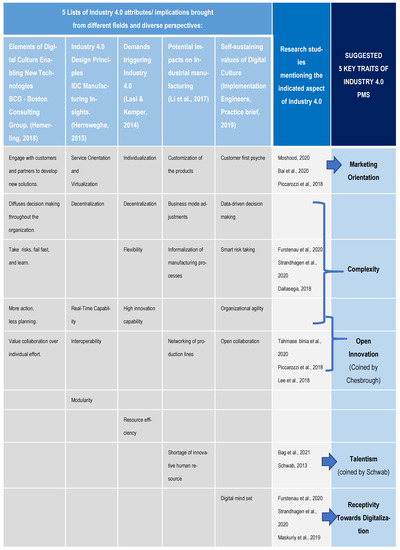

Figure 1.
The structure of logic behind the proposed five key traits of the I4.0 PMs.
Construction projects are extremely complex, contain high risk and are very slow in re-sponding to changes [33]. Therefore, the general key I4.0 implications of the socially sus-tainable approach for project management prove to be interesting points of analysis in the construction industry environment.
Marketing Orientation. Brand culture, software, service quality and design, and data quality have risen in importance in the construction industry and I4.0 [13]. This can be corroborated with Hughes’ [33] hypothesis that marketing, rather than project management, is responsible for most aspects of problems with client satisfaction in terms of construction projects. These issues might be further accentuated by the development of new digital technologies in construction. Building Information Modelling (BIM) is considered the central technology, and next to it, the three main concept clusters are smart factory, simulation and modeling and digitalization and virtualization are gaining importance in construction [34]. In the future, varieties of simulation and modeling techniques such as Augmented Reality (AR)/Virtual Reality (VR)/Mixed Reality (MR) and Human-Computer-Interaction (HCI) are expected to be fundamental aspects in managing customer relationships and marketing [35]. These new insights are important aspects of I4.0 mass customization trends that demand an in-depth, detailed knowledge and understanding of the customers’ requirements. The winners of the market competition will be the companies with special emphasis on the customization of their products to be as unique as possible [32].
Complexity and Agility. Strandhagen et al. (2020) [36] discussed engineer-to-order (ETO) industries such as shipbuilding and construction as much more complex and dynamic than the repetitive manufacturing approaches and concluded that the ETO context seemingly greatly impacts the applicability of I4.0 technologies. Construction sites are usually characterized by high variability and unpredictability. This characteristic makes the synchronization of supply chains to the construction progress complex. Deficiencies in these chains pose a sustainability problem, and an optimization is an approach to it. As I4.0 projects are complex instead of the traditional approaches used by the PM community [37], new methodologies (such as agile) will be more suitable for these new I4.0 projects. In these new agile work environments, product development occurs alongside the advancement of technology and specifications [38]. Each new product development stage improves the product value until the final product is created. Apart from the agile methodology, the ‘learning-emerging’ concept is another approach that can be used, [38] argues that instead of a planning and instructional project management approach, the so-called “learning approach” should be implemented so that projects will “emerge” instead of being completely pre-planned. With the increase in the number of disciplines participating in a single project, managerial complexities also increase, resulting in the need for project managers to have cross-disciplinary management capabilities. This holds in particular when the organizational cultures of the engaged organizations are diverse and perhaps incompatible. These described project complexity definitions are mainly applicable to manufacturing and IT. As construction is already fundamentally an exceptionally complicated and multi-faceted industry, the additional complexity and agility traits of the I4.0 projects might imply a significant challenge.
Open Innovation. Lee et al. (2018) [39] concluded that the most effective way to address I4.0 is by dynamic open innovation business models and open innovation culture. Open Innovation offers excellent potential to firms in the construction industry; however, the immediate response can be the question of privacy. As [40] explained, the issue of privacy in the interconnected I4.0 network needs some special attention.
“Open innovation” was first introduced by Chesbrough (2006) [41], who posited that collaboration between companies is important in the technological age to ‘synergize internal and external concepts, ideas and ways to market.’ This is so as not all necessary knowledge can be created by the organization itself, where valuable knowledge needs to be created both inside and outside the organization [42]. Therefore, it is not long before open innovation methodologies are incorporated within innovative practices, requiring the need for PMs to easily adapt to innovative environments [43,44]. It is important for project managers to comprehend and be able to work within distributed network environments, to drive the collaborative network and to build trust between the employees and the company [45,46,47].
Talentism. Imagination and the ability to innovate are the drivers of success, and the most important element of innovation is high-quality human capital, a rare resource called ‘talent’. In I4.0, management focus has shifted to increasing motivation among employees to develop their potential. In this age, creativity, innovation and human talents have surpassed the importance of capital in production. Hence, it is clear how human capital is now extremely important in determining a company’s success [48].
Apart from human talent, the transfer of knowledge and the cooperative capabilities of employees have also become key determinants of an organization’s success [49,50]. Businesses need to comprehend that “collaboration on talent issues, rather than competition, was no longer a nice-to-have but rather a necessary strategy” [51]. This is in contrast to the past, where technical facets proved to be more important in company success, resulting in a greater focus on employees’ technical abilities. In I4.0, employees’ soft skills have become more important in determining their value to a company. These shifts were indicated in ‘The new talent landscape’ report by [52], which determined the importance of skills in determining the hiring of project management positions. Soft skills that include interpersonal relations, teamwork, problem-solving skills, communication and leadership skills were the most important skills, coming in at 45% of responses. The second most important skills at 39% were indicated to be IT and project management skills. With the increasing incorporation of IT into the work environment, social skills, creativity and empathy have become more critical traits in employment. Within the construction sector, communicating and coordinating with stakeholders proved to be important skill sets [34].
Digitalization. Digitization is not a goal rather than a medium of work. As noted by [6], the experience gained in handling these tools will allow the establishment of stronger organizational cultures, whose decisions are based on data, and, consequently, the organization will be able to tackle complex projects more sustainably. Digitalization can help construction companies to reduce costs, save time and respond efficiently to customer requests as part of the discovery practice and constant development to make them more sustainable [47].
The key relevance of I4.0 for construction is categorized by 3D value chain models: smart factory, simulation and modeling and digitization and visualization. This digital simulation and modeling capacity has many benefits (cost/time, quality control, effective communication and collaboration, building customer relationships and scientific safety measures) but above all the sustainability assurance [40].
AI’s relevance to PM roles comes in the form of data collection, tracking and reporting. Creating a fully digital program management office is in the works by many PPM companies. With the increase in AI’s relevance, employees who can deal with AI and smart machines have become extremely important. As AI becomes the priority of project management, it is expected that human error regarding project issues and risks will decrease. With the rise of I4.0, it is expected that machines will be seamlessly introduced into all aspects of business operations [35,46]. Thus, this further highlights the importance of gaining skills required to manage AI machines. It is expected that the knowledge worker will help enhance this digital transformation through transforming big data into knowledge. When projected against the business economy, it becomes essential that project managers possess the digital skill set required to work well in I4.0 alongside new technologies [35,43].
2. Materials and Methods
This paper relied on sources published from 1963 to 2021. The wide time range enables the paper to take on a broader perspective in understanding the trajectory of the topic covered in this paper. In addition, a survey questionnaire was formulated based on findings from the literature review.
The authors have specifically chosen the GCC construction industry to conduct the survey questionnaire. The reason for this is that the GCC governments have been long engaged with sustainability and diversification that is shown in the national social and economic development plans such as Saudi Arabia’s Vision 2030, Oman Vision 2040, UAE Vision 2021, Kuwait Vision 2035, Bahrain Economic Vision 2030 (Oxford Business Group). They have also been highly involved with the I4.0 processes. In 2017 the UAE launched the ‘UAE Strategy for the 4IR,’ and in 2019, they appointed the first dedicated ambassador for the fourth industrial revolution in the world. In 2018 the government and the WEF agreed to establish the ‘Centre for the 4IR’, the first Digital Centre in the Middle East that can tap into an expansive global network and will support the growing focus on digital initiatives of businesses in the public and private sectors across the GCC region. In 2018 the national authorities formed the Artificial Intelligence Council. In 2017 Dubai launched an IoT strategy that aimed to build the world’s largest IoT ecosystem [53]. Given all these massive GCC government initiatives, targeting I4.0 advancements and construction projects as part of the national development plans, the social sustainability aspects of all these substantial processes is a very relevant question to ask.
The questionnaire survey method has been commonly used to collect data from construction enterprises, such as in China and Oman [54,55,56,57]. Further to all these major government initiatives and investment projects, a survey questionnaire was developed to assess the state of readiness for I4.0 in the GCC construction industry. One hundred questionnaires were sent to 100 professionals. The professionals were selected from LinkedIn, bearing in mind that they possessed experience as construction/PMs or seniors. Questionnaires were distributed between April to July 2020. In creating the survey questionnaire, the five key assets of project management discussed in the earlier section were drawn to create three questions for each asset. These five key assets are (1) marketing orientation, (2) open innovation, (3) complexity and (4) talentism, (5) digital receptivity. Questions related to the various categories can be found in the Supplementary Material.
In responding to the surveys, respondents were first required to state their academic and professional qualifications. They were then required to respond to the questions by rating their responses on a scale of 1 to 5. 1 indicates that the survey respondent strongly disagrees with the asked question; 2 indicates that the respondent slightly disagrees, 3 indicates that the respondent has a neutral opinion on the question, 4 indicates that the respondent agrees and 5 indicates that the respondent strongly agrees with the asked question.
3. Results
Based on the results from the questionnaire, it was determined that the technical nature of construction skills, the multidisciplinary and regulatory environment and the challenging working conditions made the role of PMs in the construction industry especially complicated. Based on the responses from the first survey question, it was determined that a large majority (82%) of the respondents had both academic and professional qualifications. 14% of the respondents only had professional qualifications, while 4% only had academic qualifications. These results are exemplified in Figure 2 below.
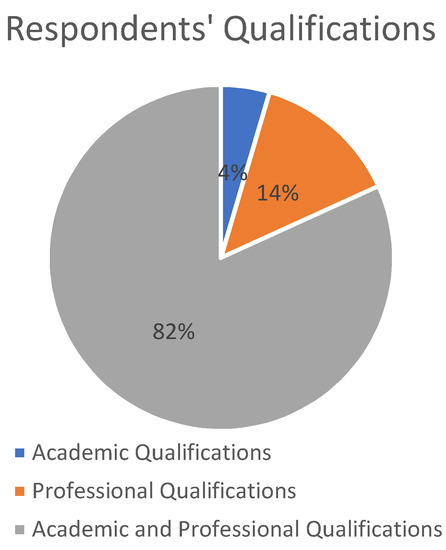
Figure 2.
Project managers qualifications.
For the second survey question that determined the respondents’ GCC country location, it was found that a majority (64%) were based in Oman. The remaining 27% were based in Saudi Arabia, 4.5% in Qatar and 4.5% in UAE. These results are presented in Figure 3. The following questions delved into three questions, each targeting the five key assets—open innovation, marketing orientation, digitalization receptivity, talentism and complexity.
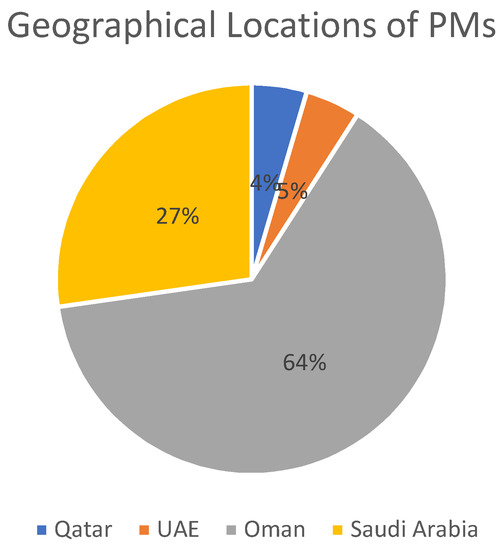
Figure 3.
Geographical Locations of PMs.
3.1. Marketing Orientation
Questions 1.1, 1.2 and 1.3 assessed the respondents’ opinions concerning how important they find marketing orientation is to the PM profession. As discussed in earlier sections, marketing orientation is key in understanding how psychological factors influence marketing decisions in I4.0. In order to determine the importance of marketing orientation, the behavior and expectations of clients and project stakeholders must first be understood. The responses to Q 1.1, 1.2 and 1.3 are represented in Figure 4, which presents the average of the answers.
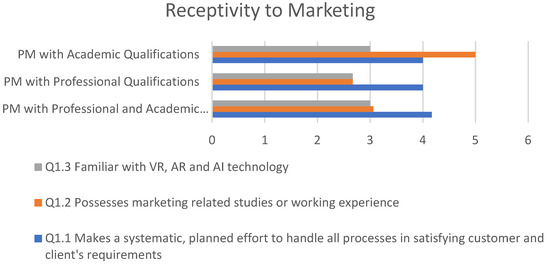
Figure 4.
Receptivity of PMs to Marketing.
It should be noted that marketing orientation is dependent on many different traits apart from the physical characteristics of a product. Through the responses, it was found that PMs who had both academic and professional qualifications were compliant with customer demands and protocol to deal with client demands. They expressed neutrality when questioned about technological familiarities as well as marketing studies. On the other hand, PMs with only professional qualifications (15%) had similar results. However, they were found to be more familiar with new technologies and did not have prior marketing studies. PMs only with academic qualifications (5%) were neutral towards new technologies. However, also agreeing to the importance of prior marketing studies and creating a protocol to meet clients’ requirements.
3.2. Open Innovation Responses
Market competitiveness and business strategies have become much more complex as a result of technological advancement. As shown in Section 2, the increased innovation and complex environment caused by I4.0 will put a new strain on the PM profession [58,59,60]. Therefore, the 3rd category of questions (Q 3.1, 3.2, 3.3) aimed to determine how well PMs understood open innovation and how relevant they thought this was to their job scope. The responses from the survey are represented in Figure 5.
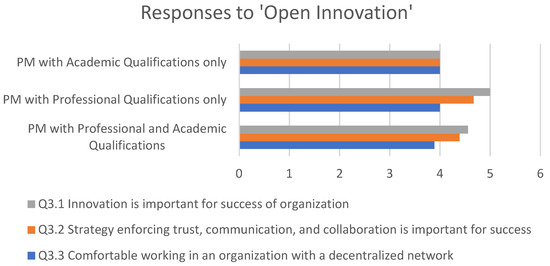
Figure 5.
Responses to ‘Open innovation’.
Open innovation is highly beneficial for companies during this technological age. With open innovation, companies’ cooperation can spur creativity, innovation and generate unique ideas and concepts. Therefore, PMs’ different set of work attitudes and competencies will be required, more specifically in their innovative and PM capabilities.
Based on the responses collected, PMs with professional and academic qualifications have a strong understanding of open innovations concepts and relevant mindsets. However, they were proven to have lower confidence when it came to working in a decentralized network environment. PMs only with professional qualifications presented the same responses, except for how they understood the importance of innovation even better. PMs only with academic qualifications also had similar responses to open innovation.
3.3. Preparedness for Project Complexities
The increasing complexity of projects is expected alongside the increased complexity in technological and organizational orientation. Therefore, the 4th category of questions (Q 4.1, 4.2, 4.3) aimed to determine respondents’ readiness for project complexities. The results are presented in Figure 6.
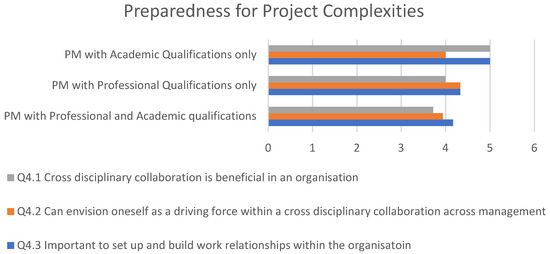
Figure 6.
Preparedness for Project Complexities.
Even though the construction industry has not been fully exposed to agile methodologies, it was found that respondents firmly understood the related concepts. PMs only with professional qualifications fared especially well in this area, apart from concepts on cross-disciplinary management as they did not believe in the benefits of managing different cultures together. Finally, the group that fared the best in this area were PMs with only academic qualifications.
3.4. Talentism
Human capital and talentism have been shown to be important determinants in the company’s success [41,48]. This aspect was investigated through the 5th category of questions (Q5.1, 5.2, 5.3), where the responses are shown in Figure 7.
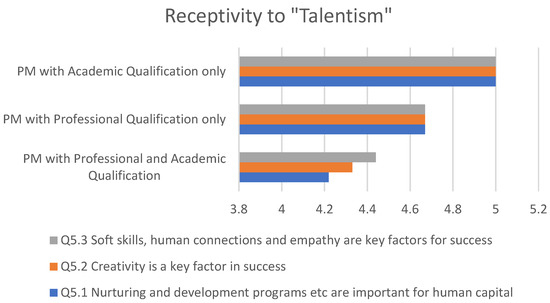
Figure 7.
Receptivity to “Talentism”.
3.5. Digital Receptivity
Overall, the impact of digitalization on ‘market standards, working infrastructure, machinery, business and operations’ have been emphasized several times [35]. Therefore, it is important to determine the perspectives of PMs towards this aspect. The following three questions (Q 2.1, 2.2, 2.3) delved into these aspects, and the resultant responses are indicated in Figure 8.
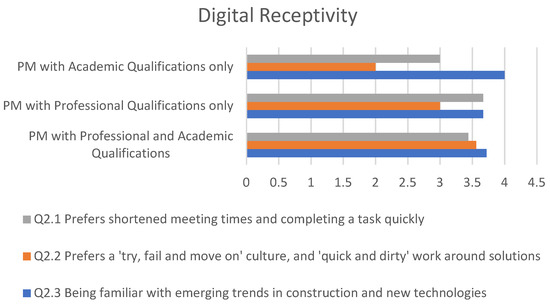
Figure 8.
Digital Receptivity.
Digitalization has proved its importance in helping to spur development in the construction industry that will maximize efficiency. Some of the ways where digitalization can contribute to development revolve around new technologies such as building information modeling (BIM), 3D printing and the Internet of Things (IoT), among many others. Therefore, these technologies in digitalization will be key in spurring economic diversification and large-scale national transformation.
The survey has shown that PMs with professional and academic qualifications and PMs only with professional qualifications were mostly highly receptive to digitalization. PMs only with academic qualifications strongly understood new technologies, but fared the worst in the ‘try, fail fast, and move on’ work culture.
PMs who had both academic and professional qualifications showed strong understanding and belief in nurturing talents and developing employees’ capabilities. However, social skills and creativity were more highly prioritized.
PMs with professional qualifications provided similar responses but showed a strong understanding of the concepts of talentism. PMs only with academic qualifications indicated that talentism was the key factor determining success in I4.0.
4. Discussion
The present study falls within the category of recent research focused on individual and organizational competencies needed for absorbing ongoing transformations in industry and society in general (e.g., [14,35,39]). More specifically, the research focuses on the ‘worker-centric’ human factor aspect of I4.0’s social sustainability in the GCC construction PM profession. The emerging issues and potential implications and are complex and multifaceted.
There is something of a consensus around the idea that digitalization triggered by new technological innovations must lead to a restructuring of the supply chain and a corollary (re)qualification of skilled workers (see especially [4,10,14]. As pointed out by several researchers, there will be new increasingly knowledge-intensive jobs created by these new I4.0 trends. In this paper, the assumed new skillset needed for I4.0 has been drawn from the literature and has been distilled into five categories: (1) marketing orientation, (2) open innovation, (3) complexity and (4) talentism, (5) digital receptivity. These specific skills are built upon each other to ensure that PMs can effectively handle all internal and external aspects required for PM. Digital receptivity forms the core of these assets to turn the organization towards I4.0 [61]. Together with digital receptivity, PMs must be able and prepared to handle the high level of project complexity and use and understand the importance of open innovation. These would target the internal and external aspects of PM, respectively. The multifaceted nature of the I4.0 projects would require the collaboration of various disciplines inside and outside the organization and tap into novel skills and ideas. Therefore, to manage the project well internally, PMs must have cross-disciplinary management capabilities to ensure the effective coordination of all required disciplines required to develop the product and increase its value. However, solely relying on the internal aspects of the organization is not enough to maximize product value. External collaboration with other organizations to synergize internal and external concepts, ideas and marketing methods, is also essential to ensure that product value is maximized to its full potential. Hence, PMs need to possess the open innovation skillset to collaborate externally with other organizations. It should be noted that while the coordination of such concepts and ideas is essential, without the talents of human capital, such concepts and ideas will not be able to come to fruition.
Researchers have emphasized the importance of human resources in applying new technological skills. Thus, the asset of talentism comes into play as the soft skills of human capital are important in ensuring that the product development ideas are carried out efficiently and effectively to maximize quality [62]. Once the product has been developed, the importance of the marketing orientation skill asset is critical in tackling client satisfaction to ensure that clients are receptive to the developed product. Therefore, it is clear that the management of projects from the beginning where ideas are conceptualized to the final development and delivering of the product to clients requires the five main assets from PMs that we have identified throughout the study. Eventually, these five skills harmonize with the proposed framework introduced by Lee and Lim, ‘Convergence in I4.0’, where people, objects and organizations are combined with the services of AI and data to produce a value [62]. Figure 9 shows the framework of the five skills harmonized with Lee and Lim’s proposed framework.
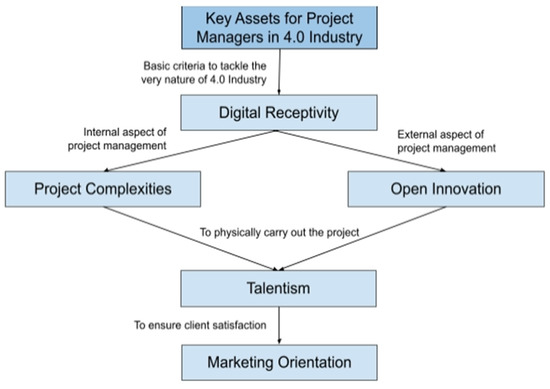
Figure 9.
Relationship of key I4.0 skill areas with the framework research proposal.
As a fully realized I4.0 is still not totally clear for most practitioners, it is, of course, not the case that only these five categories are important in ensuring an expedient reaction to I4.0 transformation. Instead, these five categories together constitute a set of core competencies and attitudes that helps for a manageable I4.0 transformation process and sufficiently cover the entire spectrum providing a relatively accurate starting point for predicting the sustainable impact of I4.0. Therefore, it is plausible that if an organization or industry scores low on all or the majority of these issues, their risk of being side-lined during the digital transformation is fairly high. The impossibility of determining with precision the definite set of skills needed to accommodate I4.0, in part, is related to the complexity of the process itself.
As Donaldson established in 1996, successful decision-making depends on understanding the internal and external factors influencing the system; these are called contingency factors [63]. Concerning internal factors and the logic of operation of the construction sector at a global level, as Lizarralde pointed out in the construction sector, project team members come together through a group is not really a team. It is a temporary multi-organization (TMO) [64]. It is temporary because it lasts only for the duration of a single project, at the end of which the members separate, which must be taken into account to evaluate the competencies of the necessary team members. Regarding external factors, in Newcombe’s work in 1996, societies were increasingly plural and in which more stakeholders decided on projects [65].
Further to Donaldson’s internal and external influencing factors, the discussion of intrinsic and extrinsic barriers is of great importance in terms of I4.0’s realization. According to the UK Manufacturers Organization’s survey (2018), companies generally go through three phases of development before they can fully embrace the I4.0 concept. The first is the ‘Pre-conception’ phase, when companies have not really shown real interest or have not invested in this concept at all. The second is the ‘Conception’ phase, when there is some interest and a certain level of investment into I4.0, and the third is the ‘Evolution’ phase, when companies are able to engage and harvest the I4.0 benefits fully. To achieve the final ‘Evolution’ stage, companies have to come over several barriers. The survey concluded that generally, they have to overcome the intrinsic, internal barriers and then proceed with the extrinsic, external barriers for successful adoption.
The intrinsic barriers identified by the mentioned 2018 UK survey are the following: (i) Lack of skills within business implementation, (ii) Data compatibility between systems, (iii) Not understanding how technologies can help our business, (iv) Culture within our business towards change, (v) Lack of available finance to invest, (vi) Cybersecurity concerns, (vii) Unable to build an investment case, (viii) Not knowing where to go for information, (ix) Lack of buy-in from management, (x) Lack of buy-in from employees.
In terms of I4.0 extrinsic barriers, PWC reports the following (PWC and WEF, 2020. Unlocking Technology for the Global Goals.): (i) The differences in data interoperability, quality and volume, (ii) Differences in technology maturity, (iii) A lack of wider pool of individuals with 4IR expertise, (iv) Inadequate financing models, (v) Gap between rapid technological advancements and governance and regulations.
These described development stages and barriers are taken from the manufacturing industry, which is quite well aligned with I4.0 initiatives. In terms of construction, several more and completely unforeseeable barriers might arise due to this industry’s very different, rigid and complex nature. Accordingly, the described developmental phases and barriers should serve only as a general guidance in relation to our current study.
I4.0 concept is particularly suitable for the manufacturing and IT industry, but its applicability to other industries remains uncertain. In general, the construction and materials industry is one of the lowest R&D intensity sectors, with less than 1% of net sales according to a 2015 EU survey. This is a surprising finding as the construction industry is usually one of the major contributors to the employment and economy of each country [34]. Looking at the GCC region, these figures are a bit different, as Saudi Arabia is investing USD 56 billion in advanced construction technology sectors and R&D as of 2020. The construction industry operates in complex environments, resulting in multiple layers of disciplinary and managerial approaches (Oxford Business Group). Furthermore, given that construction projects are extremely complex and come with high risks, they are very slow in responding to changes. Due to these challenges, [34] concludes that companies to be motivated for the adoption of government mandates, initiatives or funding programs are necessary, requiring in-depth research of the construction industry from the I4.0 aspects. Therefore, these dynamics prove to be interesting points of analysis [66].
With such a systemic change towards integration and interoperability, it will be neither possible nor necessary to insist on a definitive set of skills needed to profit from the 4.0 transformation. The resulting openness is thus fruitful for both academic and practical purposes. On the other hand, the study results clearly demonstrate that respondents with both professional and academic qualifications are more open and aware of the I4.0 trends. While respondents with only academic or professional qualifications are hesitant or unsure to respond or even participate in the survey, their counterparts with professional and academic qualifications are well-informed, interested and willing to test their knowledge and attitude towards I4.0. This was a very important realization of the conducted survey questionnaire. In the review carried out by Maskuriy [40] they point out the importance of convincing workers that the company’s sustainability depends on innovation and targeted training. For sustainability in construction projects, the companies need to develop a workforce with both academic and professional qualifications.
While it is very appealing and powerful to imagine all these major restructuring processes, their real-life adaptations are different scenarios. There is a consensus around the importance of PMs in fostering, accelerating and exploiting the digital transformation, however, it is difficult to determine at this juncture how exactly this role will materialize. Consider for example talentism [18,48]. While it is clear that PMs will need to have as an end-point a focus on their employees’ soft skills and creativity, fostering an organizational culture where such aspects are encouraged and rewarded, it remains open for discussion how such organizational cultures are to be achieved. To a great extent, this depends on the concrete direction taken by I4.0 and other (larger) organizational, societal and global trends and changes. To the questions of how long does it take to make these changes? How deep must they be? We can say in the past, it would take decades, even centuries, to make profound changes in the formation of society and the economy. However, everything has accelerated [1,3] we are in the center of a Cybernetic Revolution, which means annual cycles of profound changes with aims to institutionalize innovation systems.
As the authors of the present work have already shown in previous publications [55,56], the introduction of environmental aspects as the central axis of the construction industry in the GCC area is an important but still incipient aspect. The double challenge of incorporating I4.0 and sustainability as an essential part of it being a priority is still a challenge for PMs today, in which they will not be alone.
The most important limitation to consider for this study is the relatively low number of respondents and the overwhelming majority of highly skilled PMs (meaning both professional and academic credentials).
There is a huge and very interesting research potential for future studies in this subject area, as the human aspect of sustainability has been relatively underrepresented in the research literature until now. Just as an example, and building on the concepts introduced in this paper, both researchers and managers could be involved in studying of planning and creation of future increasingly knowledge-intensive new jobs. These new job descriptions are not existing yet, but will be necessary in I4.0. New motivational, knowledge management and knowledge transfer techniques for the workforce and management are also important topics for future progress. The different managerial and leadership styles, potentially with more emphasis on soft skills, and these impact on the workforce is also a promising area of study. Future research can provide a more empirical grounding for the present results approach zoom in at a micro-level and investigate the specific skills needed in concrete situations and for concrete organizations. Additionally, a qualitative study can provide more depth to the categories selected, clarifying for instance how the PMs themselves see the selected five categories and how they interpret their responsibility in acquiring the skills in question.
5. Conclusions
The usage of new I4.0 technologies is still in the early stages in the construction industry. According to the research literature, the socially sustainable worker-centric I4.0 approach is in an embryonic stage not only in construction, but generally in all industries. With the onset of I4.0, new talents that possess relevant skillsets will be in increasing demand. In addition, the increase in collaboration across various supply chains in the construction business has been encouraged in I4.0. As a result of such changes, organizations also need to alter their workflow. The increased introduction of new technologies will require project managers to understand how to use and work with these technologies and, most importantly, how to manage the new I4.0 workforce.
This paper studied how construction PMs based in the GCC countries were prepared to deal with these digital transformations from the aspect of the worker-centric view, based on five key assets identified in the literature review. Overall, it was found that PMs reacted positively towards the five key assets. However, they were found to be less familiar with new technologies that include Artificial Intelligence and Virtual Reality, among many others. The results from the survey demonstrate the need for increased exposure and training for GCC PMs to become more familiar with these technologies. It was also determined that PMs with academic and professional qualifications demonstrated a more robust understanding and preparedness for I4.0, highlighting the importance of increased training and exposure for all PMs to be fully prepared for the new I4.0 transformation.
The novelty and originality of the present study is that it tries to investigate the ‘worker-centric’ social dimension from a profoundly intrinsic and human factor perspective. An important aspect of the paper’s findings is that the study was conducted in the construction industry, which is well-known for its rigid and firm culture and strong resistance to changes. This type of more human, worker-centric approach could be important for the successful realization of I4.0 projects in the construction PM sector as well.
Supplementary Materials
The following are available online at https://www.mdpi.com/article/10.3390/su13158121/s1.
Author Contributions
Conceptualization, M.M.-P. and T.A.A.; methodology, M.M.-P. and T.A.A. and K.P.K. All authors have read and agreed to the published version of the manuscript.
Funding
With the support of a grant from the Xunta de Galicia (Competitive Reference Groups ED431C-2021-27).
Conflicts of Interest
The authors declare no conflict of interest.
References
- Margherita, E.; Bua, I. The Role of Human Resource Practices for the Development of Operator 4.0 in Industry 4.0 Organisations: A Literature Review and a Research Agenda. Businesses 2021, 1, 18–33. [Google Scholar] [CrossRef]
- Neumann, W.P.; Winkelhaus, S.; Grosse, E.H.; Glock, C.H. Industry 4.0 and the human factor—A systems framework and analysis methodology for successful development. Int. J. Prod. Econ. 2021, 233, 107992. [Google Scholar] [CrossRef]
- Schiele, H.; Bos-Nehles, A.; Delke, V.; Stegmaier, P.; Torn, R.-J. Interpreting the industry 4.0 future: Technology, business, society and people. J. Bus. Strat. 2021. [Google Scholar] [CrossRef]
- Margherita, E.G.; Braccini, A.M. Industry 4.0 Technologies in Flexible Manufacturing for Sustainable Organizational Value: Reflections from a Multiple Case Study of Italian Manufacturers. Inf. Syst. Front. 2020, 1–22. [Google Scholar] [CrossRef]
- Wiig, K.M. People-Focused Knowledge Management: How Effective Decision Making Leads to Corporate Success; Butterworth-Heinemann: Oxford, UK, 2004. [Google Scholar]
- Furstenau, L.B.; Sott, M.K.; Kipper, L.M.; Machado, Ê.L.; Lopez-Robles, J.R.; Dohan, M.S.; Cobo, M.J.; Zahid, A.; Abbasi, Q.H.; Imran, M.A. Link Between Sustainability and Industry 4.0: Trends, Challenges and New Perspectives. IEEE Access 2020, 8, 140079–140096. [Google Scholar] [CrossRef]
- Vrchota, J.; Řehoř, P.; Maříková, M.; Pech, M. Critical Success Factors of the PM in Relation to I4.0 for Sustainability of Projects. Sustainability 2021, 13, 281. [Google Scholar]
- Sony, M.; Naik, S. Critical factors for the successful implementation of Industry 4.0: A review and future research direction. Prod. Plan. Control 2020, 31, 799–815. [Google Scholar] [CrossRef]
- Sony, M.; Naik, S. Key ingredients for evaluating Industry 4.0 readiness for organizations: A literature review. Benchmarking Int. J. 2019, 27, 2213–2232. [Google Scholar] [CrossRef]
- Bonekamp, L.; Sure, M. Consequences of I4.0 on Human Labour and Work Organisation. J. Bus. Media Psychol. 2015, 6, 33–40. [Google Scholar]
- Kagermann, H. Change through digitization—Value creation in the age of I4.0. In Management of Permanent Change; Springer Gabler: Wiesbaden, Germany, 2015; pp. 23–45. [Google Scholar]
- Kahneman, D. Maps of Bounded Rationality: Psychology for Behavioral Economics. Am. Econ. Rev. 2003, 93, 1449–1475. [Google Scholar] [CrossRef] [Green Version]
- Singapore Management University. Disruption: The New Norm? Singapore Management University: Singapore, 2017. [Google Scholar]
- Zervoudi, E.K. Fourth Industrial Revolution: Opportunities, Challenges, and Proposed Policies. In Industrial Robotics—New Paradigms; InTech: London, UK, 2020. [Google Scholar]
- Park, S.H.; Shin, W.S.; Park, Y.H.; Lee, Y. Building a new culture for quality management in the era of the Fourth Industrial Revolution. Total Qual. Manag. Bus. Excel. 2017, 28, 934–945. [Google Scholar] [CrossRef]
- Simon, H.A. Models of Man: Social and Rational-Mathematical Essays on Rational Human Behavior in a Social Setting; John Wiley: New York, NY, USA, 1957. [Google Scholar]
- Wiig, K.M. Knowledge Management: An Emerging Discipline Rooted in a Long History; Chauvel, D., Despres, C., Eds.; Elsevier: Amsterdam, The Netherlands, 2000. [Google Scholar]
- Beach, G. ’Talentism’ Is the New Capitalism. The Wall Street Journal. 2014. Available online: https://www.wsj.com/articles/BL-CIOB-4981 (accessed on 14 July 2021).
- Jiang, Z.; Wang, Z.; Feng, C. Balancing the strength of external and internal ties for tacit knowledge management. Technol. Anal. Strat. Manag. 2020, 32, 785–800. [Google Scholar] [CrossRef]
- Kamaşak, R.; Bulutlar, F. The influence of knowledge sharing on innovation. Eur. Bus. Rev. 2010, 22, 306–317. [Google Scholar] [CrossRef]
- Zhang, D.J.; Zhao, L. Knowledge management in organizations. J. Database Manag. 2006, 17, 1–9. [Google Scholar]
- Hausmann, R.; Hidalgo, C.A.; Bustos, S.; Coscia, M.; Simoes, A.; Yildirim, M.A. The Atlas of Economic Complexity: Mapping Paths to Prosperity; MIT Press: Cambridge, MA, USA, 2014; Available online: https://s3.amazonaws.com/academia.edu.documents/30678659/HarvardMIT_AtlasOfEconomicComplexity_Part_I.pdf?A (accessed on 3 August 2020).
- Winter, S.G. Knowledge and competence as strategic assets. In The Competitive Challenge; Teece, D.J., Ed.; Ballinger Publishing: Pensacola, FL, USA, 1987. [Google Scholar]
- Polanyi, M. The Logic of Tacit Inference. Philosophy 1966, 41, 1–18. [Google Scholar] [CrossRef]
- Schindler, J. Expertise and tacit knowledge in artistic and design processes: Results of an ethnographic study. J. Res. Pract. 2015, 11, M6. [Google Scholar]
- Mascitelli, R. From experience: Harnessing tacit knowledge to achieve breakthrough innovation. J. Prod. Innov. Manag. 2000, 17, 179–193. [Google Scholar] [CrossRef]
- Nonaka, I. The Knowledge-Creating Company. Harv. Bus. Rev. 1991, 68, 96–104. [Google Scholar]
- Collins, H. The TEA Set: Tacit Knowledge and Scientific Networks. Sci. Stud. 1974, 4, 165–185. [Google Scholar] [CrossRef]
- Price, D.J. Little Science, Big Science; Columbia University Press: New York, NY, USA, 1963. [Google Scholar]
- Dima, A.M.; Vasilache, S. Social Network Analysis for Tacit Knowledge Management in Universities. J. Knowl. Econ. 2015, 6, 856–864. [Google Scholar] [CrossRef]
- Barabási, A.L. Bursts: The Hidden Patterns Behind Everything We Do, from Your E-Mail to Bloody Crusades; Penguin: London, UK, 2010. [Google Scholar]
- Sima, V.; Gheorghe, I.G.; Subić, J.; Nancu, D. Influences of the Industry 4.0 Revolution on the Human Capital Development and Consumer Behavior: A Systematic Review. Sustainability 2020, 12, 4035. [Google Scholar] [CrossRef]
- Lowe, D.; Leiringer, R. Commercial Management—Defining a Discipline? In Commercial Management of Projects: Defining the Discipline; John Wiley and Sons Ltd: Hoboken, NJ, USA, 2006; pp. 1–17. [Google Scholar]
- Corby, C. Deloitte GCC Powers of Construction 2020 (10th ed). A New Normal for a New Decade. 2020. Available online: https://www2.deloitte.com/xe/en/pages/real-estate/articles/gcc-powers-of-construction-2020.html (accessed on 14 July 2021).
- Botha, D.F. Knowledge Management and the Digital Native Enterprise. Advances in Logistics, Operations, and Management Science; IGI Global: Hershey, PA, USA, 2019; pp. 207–239. [Google Scholar]
- Strandhagen, J.W.; Buer, S.-V.; Semini, M.; Alfnes, E. Sustainability challenges and how Industry 4.0 technologies can address them: A case study of a shipbuilding supply chain. Prod. Plan. Control 2020, 1–16. [Google Scholar] [CrossRef]
- Lundvall, B.-Å.; Johnson, B.; Andersen, E.S.; Dalum, B. National systems of production, innovation and competence building. Res. Policy 2002, 31, 213–231. [Google Scholar] [CrossRef]
- Pajares, J.; Poza, D.; Villafañez, F.; López-Paredes, A. PM Methodologies in the Fourth Technological Revolution. In Advances in Management Engineering; Hernández, C., Ed.; Springer: Cham, Switzerland; New York, NY, USA, 2017; pp. 121–144. [Google Scholar]
- Lee, M.; Yun, J.J.; Pyka, A.; Won, D.; Kodama, F.; Schiuma, G.; Park, H.; Jeon, J.; Park, K.; Jung, K.; et al. How to Respond to the Fourth Industrial Revolution, or the Second Information Technology Revolution? Dynamic New Combinations between Technology, Market, and Society through Open Innovation. J. Open Innov. Technol. Mark. Complex. 2018, 4, 21. [Google Scholar] [CrossRef] [Green Version]
- Maskuriy, R.; Selamat, A.; Maresova, P.; Krejcar, O.; David, O.O. I4.0 for the con-708 struction industry: Review of management perspective. Economies 2019, 7, 68. [Google Scholar] [CrossRef] [Green Version]
- Chesbrough, H. Open Innovation: A New Paradigm for Understanding Industrial Innovation; Oxford University Press: Oxford, UK, 2006; pp. 1–19. [Google Scholar]
- Simeone, L.; Secundo, G.; Schiuma, G. Knowledge translation mechanisms in open innovation: The role of design in R&D projects. J. Knowl. Manag. 2017, 21, 1406–1429. [Google Scholar] [CrossRef] [Green Version]
- Makarova, I.; Boyko, A.; Giniyatullin, I.; Pashkevich, A.; Mukhametdinov, E. Changes in Engineering Education in the Transition to a Digital Society. In Proceedings of the 2020 21th International Carpathian Control Conference (ICCC), Vysoké Tatry, Slovakia, 27–28 October 2020; pp. 1–6. [Google Scholar]
- Achtenhagen, L.; Melander, A. Open Innovation in the Construction Industry with a Specific Focus on Swedish Wood-Construction Companies; Smart Housing Småland: Växjö, Sweden, 2014. [Google Scholar]
- Cimatti, B. Definition, Development, Assessment of Soft Skills and Their Role for the Quality of Organizations and Enterprises. Int. J. Qual. Res. 2016, 10, 97–130. [Google Scholar] [CrossRef]
- Huizingh, E.K. Open innovation: State of the art and future perspectives. Technovation 2011, 31, 2–9. [Google Scholar] [CrossRef]
- Gajdzik, B.; Grabowska, S.; Saniuk, S. A Theoretical Framework for Industry 4.0 and Its Implementation with Selected Practical Schedules. Energies 2021, 14, 940. [Google Scholar] [CrossRef]
- Sugiura, E. “Talentism” Defines Success in New Capitalism, Says Davos Chief. Available online: https://asia.nikkei.com/Editor-s-Picks/Interview/Talentism-defines-success-in-new-capitalism-says-Davos-chief (accessed on 2 April 2021).
- Caldarola, E.G.; Modoni, G.E.; Sacco, M.A. Knowledge-based approach to enhance the workforce skills and competences within the I4.0. In Proceedings of the Tenth International Conference on Information, Process, and Knowledge Management, Rome, Italy, 25–29 March 2018. [Google Scholar]
- Gábor, A.; Szabó, I.; Ahmed, F. Systematic analysis of future competences affected by I4.0. In Proceedings of the International Conference on Research and Practical Issues of Enterprise Information Systems, Cham, Switzerland, 16–17 December 2017; pp. 91–103. [Google Scholar]
- World Economic Forum. Shaping the Future of Construction: A Breakthrough in Mindset and Technology; World Economic Forum: Cologny, Switzerland, 2016. [Google Scholar]
- Society for Human Resource Management (SHRM). The New Talent Landscape. Recruiting Difficulty and Skills Shortages; SHRM: Alexandria, VA, USA, 2016. [Google Scholar]
- About the UAE, Strategies, Initiatives and Awards, Local Governments’ Strategies and Plans, Dubai Internet of Things Strategy. Available online: https://u.ae/en/about-the-uae/strategies-initiatives-and-awards/local-governments-strategies-and-plans/dubai-internet-of-things-strategy (accessed on 14 July 2021).
- Al Amri, T.; Marey-Perez, M. Project delays and cost overruns between public and private sectors in Oman. J. Public Aff. 2020, e2262. [Google Scholar] [CrossRef]
- Al Amri, T.; Marey-Pérez, M. Value Engineering as a Tool for Sustainability in the Construction Industry of Oman. Value Eng. 2020, 29, 7433–7444. [Google Scholar]
- Al Amri, T.S.M. Dilemma of PM in Oman. Ph.D. Thesis, University of Santiago de Compostela, Santiago de Compostela, Spain, 2021. Available online: https://www.educacion.gob.es/teseo/imprimirFicheroTesis.do (accessed on 14 July 2021).
- AL Amri, T.; Marey-Pérez, M. Towards a sustainable construction industry: Delays and cost overrun causes in construction projects of Oman. J. Proj. Manag. 2020, 5, 87–102. [Google Scholar] [CrossRef]
- Yap, J.B.H.; Lock, A. Analysing the benefits, techniques, tools and challenges of knowledge management practices in the Malaysian construction SMEs. J. Eng. Des. Technol. 2017, 15, 803–825. [Google Scholar] [CrossRef]
- Moshood, T. Emerging Challenges and Sustainability of Industry 4.0 Era in the Malaysian Construction Industry. Int. J. Recent Technol. Eng. 2020, 4, 1627–1634. [Google Scholar]
- Aigbavboa, C.; Thwala, W. The Construction Industry in the Fourth Industrial Revolution. In Proceedings of the 11th Construction Industry Development Board (CIDB) Postgraduate Research Conference, Johannesburg, South Africa, 28–30 July 2019. [Google Scholar]
- Lu, Y. Industry 4.0: A survey on technologies, applications and open research is-sues. J. Ind. Inf. Integr. 2017, 6, 1–10. [Google Scholar] [CrossRef]
- Lee, C.; Lim, C. From technological development to social advance: A review of Industry 4.0 through machine learning. Technol. Forecast. Soc. Chang. 2021, 167, 120653. [Google Scholar] [CrossRef]
- Donaldson, L. The normal science of structural contingency theory. In The SAGE Handbook of Organization Studies; Clegg, S.R., Hardy, C., Lawrence, T.B., Nord, W., Eds.; SAGE: London, UK, 1996; pp. 57–76. [Google Scholar]
- Lizarralde, G.; de Blois, M.; Latunova, I. Structuring of Temporary Multi-Organizations: Contingency Theory in the Building Sector. Proj. Manag. J. 2011, 42, 19–36. [Google Scholar] [CrossRef]
- Newcombe, R. Empowering the construction project team. Int. J. Proj. Manag. 1996, 14, 75–80. [Google Scholar] [CrossRef]
- Phua, F.T. Does senior executives’ perception of environmental uncertainty affect the strategic functions of construction firms? Int. J. Proj. Manag. 2007, 25, 753–761. [Google Scholar] [CrossRef]
Publisher’s Note: MDPI stays neutral with regard to jurisdictional claims in published maps and institutional affiliations. |
© 2021 by the authors. Licensee MDPI, Basel, Switzerland. This article is an open access article distributed under the terms and conditions of the Creative Commons Attribution (CC BY) license (https://creativecommons.org/licenses/by/4.0/).